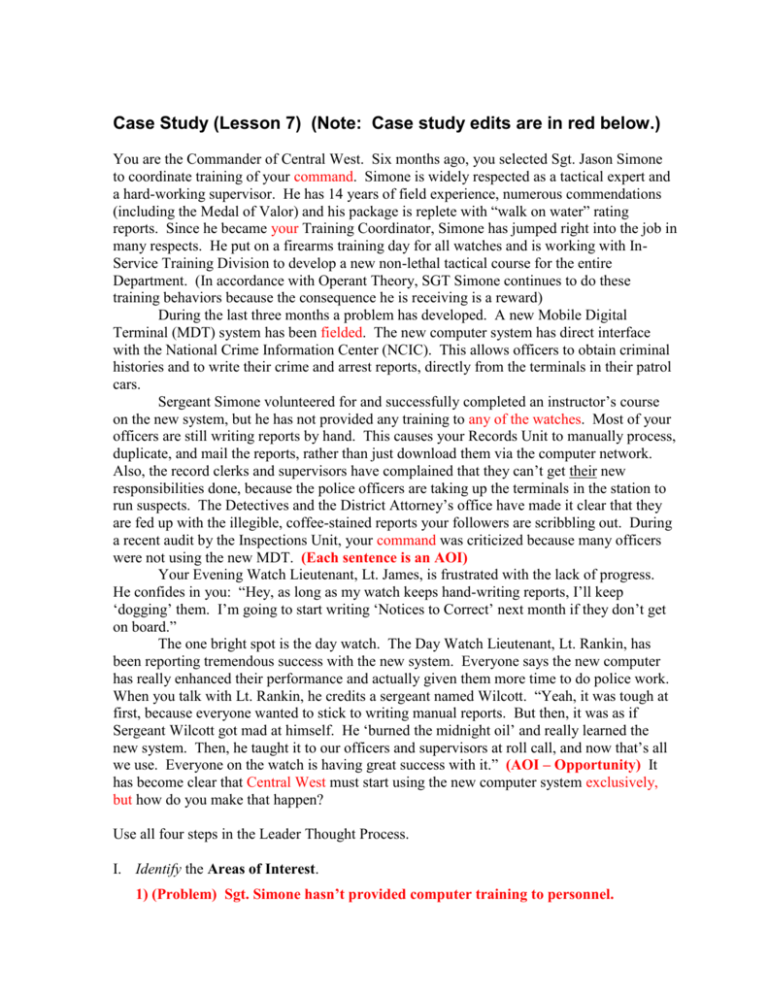Case StudyLesson7-100203 as taught
advertisement

Case Study (Lesson 7) (Note: Case study edits are in red below.) You are the Commander of Central West. Six months ago, you selected Sgt. Jason Simone to coordinate training of your command. Simone is widely respected as a tactical expert and a hard-working supervisor. He has 14 years of field experience, numerous commendations (including the Medal of Valor) and his package is replete with “walk on water” rating reports. Since he became your Training Coordinator, Simone has jumped right into the job in many respects. He put on a firearms training day for all watches and is working with InService Training Division to develop a new non-lethal tactical course for the entire Department. (In accordance with Operant Theory, SGT Simone continues to do these training behaviors because the consequence he is receiving is a reward) During the last three months a problem has developed. A new Mobile Digital Terminal (MDT) system has been fielded. The new computer system has direct interface with the National Crime Information Center (NCIC). This allows officers to obtain criminal histories and to write their crime and arrest reports, directly from the terminals in their patrol cars. Sergeant Simone volunteered for and successfully completed an instructor’s course on the new system, but he has not provided any training to any of the watches. Most of your officers are still writing reports by hand. This causes your Records Unit to manually process, duplicate, and mail the reports, rather than just download them via the computer network. Also, the record clerks and supervisors have complained that they can’t get their new responsibilities done, because the police officers are taking up the terminals in the station to run suspects. The Detectives and the District Attorney’s office have made it clear that they are fed up with the illegible, coffee-stained reports your followers are scribbling out. During a recent audit by the Inspections Unit, your command was criticized because many officers were not using the new MDT. (Each sentence is an AOI) Your Evening Watch Lieutenant, Lt. James, is frustrated with the lack of progress. He confides in you: “Hey, as long as my watch keeps hand-writing reports, I’ll keep ‘dogging’ them. I’m going to start writing ‘Notices to Correct’ next month if they don’t get on board.” The one bright spot is the day watch. The Day Watch Lieutenant, Lt. Rankin, has been reporting tremendous success with the new system. Everyone says the new computer has really enhanced their performance and actually given them more time to do police work. When you talk with Lt. Rankin, he credits a sergeant named Wilcott. “Yeah, it was tough at first, because everyone wanted to stick to writing manual reports. But then, it was as if Sergeant Wilcott got mad at himself. He ‘burned the midnight oil’ and really learned the new system. Then, he taught it to our officers and supervisors at roll call, and now that’s all we use. Everyone on the watch is having great success with it.” (AOI – Opportunity) It has become clear that Central West must start using the new computer system exclusively, but how do you make that happen? Use all four steps in the Leader Thought Process. I. Identify the Areas of Interest. 1) (Problem) Sgt. Simone hasn’t provided computer training to personnel. 2) (Problem) Night Officers are still writing reports by hand. 3) (Problem) Records Section workload has become unmanageable because officers are submitting hand-written reports that take longer to process than downloading electronic reports. 4) (Problem) Evening Officers using terminals in the station instead of their MDTs which prevents the Records personnel from doing their job downloading and filing electronic reports. 5) (Problem) Detectives and DA are fed up with the poor quality of reports, coffee stains, etc. on hand-written reports. 6) (Problem and Opportunity) Lt. James is frustrated and is “dogging” his officers. 7) (Opportunity) Day watch officers are having success with MDTs because of Sgt. Wilcott’s training efforts. 8) (Problem) Instead of doing MDT training, SGT Simon does a great job with tactical training and is currently developing a non-lethal course for the entire department. 9) (Opportunity) SGT Wilcott learned the MDT on his own and taught others on his watch. II. Analyze the situation using MTC Theory. Given the list of AOIs, is there a Logical Chain of Events &/or Root Cause(s) responsible for this situation? There appears to be a Logical Chain of Events, but not a single cause that, if addressed, would resolve a multitude of issues. Rather, in this case, issues will have to be addressed individually to resolve all of the AOIs. Had SGT Simone initiated a MDT training program when he finished his training instead of pursuing non-lethal training, then these problems could have been avoided. But looking at this situation now, dealing only with SGT Simone would only address part of the problem. SGT Wilcott is also available to help train personnel so any analysis/solution needs to look at reinforcing what is going well (SGT Wilcott’s efforts) as well as altering/changing what is not going well (SGT Simone’s activities). Which behavior(s) demonstrated by the characters in the case above is the leader attempting to increase? Sgt. Simone – Training officers on MDTs Use of MDTs by Evening shift officers Which behavior(s) is the leader trying to decrease? Officers writing reports by hand in a poor and sloppy manner. Use of computers in station by officers. Whatever SGT Simone is doing instead of conducting MDT training for officers. a. What consequences presently follow the behavior(s)/Area(s) of Interest? b. What unpleasant stimuli, if any, precede the behavior(s)/Areas of Interest? a) 1) Sgt Simone not conducting MDT training – no consequences 2) Evening officers manually writing reports – Lt. James “dogging” them and threatening officers with Notice to Correct 3) Sgt Wilcott training his officers – entire watch has more time to do police work as well as LT Rankin’s satisfaction 4) SGT Simone is conducting extensive tactical and non-lethal training – serious awards and recognition. b) Lt. James “dogging” officers and threatening officers with Notice to Correct resulting in no change in officer’s performance. What models of the desired behavior(s) are available for imitation? What models of other behavior(s) have been observed and imitated? a) Sgt. Wilcott’s training efforts. b) Day watch officers successfully using MDTs. c) Other behaviors – Evening officers appear to be content continuing manual report writing. If a new officer arrived in the Evening watch, he might learn it’s OK to do reports by hand by watching the current Evening shift manually preparing reports. To what extent are the employees capable of regulating their own behavior by monitoring themselves and administering their own consequences? Sgt Simone and officers of his watch have not demonstrated that capacity. SGT Wilcott, however, appears to be capable of self-regulation. He saw the need to learn the MDT and did it. Subsequently, he taught others what he’d learned. III. Explain What is the effect of the present consequences on the desired behavior(s)/Area(s) of Interest? See desired behaviors immediately above. As the desired behaviors have not been reinforced, they are not occurring in Central West. This is why we have the situation described in the case study. How have the consequences Sergeant Simone has experienced affected his motivation, satisfaction, and/or performance? SGT Simone continues to conduct tactical training and planning for the non-lethal training for the entire department as he is receiving positive reinforcement for these behaviors. There is no apparent consequence to reinforce SGT Simone’s MDT training, hence he is not motivated to train his officers on MDT’s IV. Select. Which theoretical strategies would be effective in this situation? There are several combinations of theoretical solutions that can achieve the desired results. Among them: Reward: SGT Wilcott’s initiative and MDT use in general need to be rewarded so these behaviors continue. Also, once SGT Simone starts MDT training, you should positively reinforce (reward) so it will continue. Punishment: Manual report writing and whatever SGT Simone is doing need to be punished so they will stop. Negative Reinforcement: The above punishment scenario sets up a negative reinforcement situation for SGT Simone’s new MDT training behavior and evening watch electronic reporting. Extinction: In lieu of punishment, you could withhold the rewards SGT Simone is receiving for his tactical and non-lethal training so this behavior will decrease/cease. Which leader strategy(ies) should the leader use? I would use reward for Wilcott and MDT use, punishment for manual report writing, extinction for SGT Simone’s tactical and non-lethal training, and reward for SGT Simone’s MDT training. V. Apply the theoretical leader strategy(ies) to the situation in the form of a specific leader plan that addresses all Areas of Interest Beginning on the next page (and using Continuation Sheets if necessary), write a leader plan of action. Address all the Areas of Interest you have identified and translate the theoretical leader strategies into specific actions you would take and communications that you would send to the employee(s) of interest. What will you do and say to whom, when, where, and how? What do the theoretical leader actions look like in practice? Any SPECIFIC leader actions that follow from the Select Step but keep in mind that in its purest form, Operant Theory is behavior and consequence. Hence, we don’t set goals, objectives, etc. by communicating with someone. In practice, however, we can punish undesired behavior, tell someone what you expect and then reward them when they do what they’re expected to do to shape the new behavior. The same approach could be used with extinction, i.e., withhold reward for undesired behavior, then tell someone what is expected and reward it when it occurs. VI. Assess the effectiveness of your leader plan. After your leader plan, list the measures you would use to evaluate your actions. In this step leaders need to ask themselves “what information do I need to tell whether or not my leadership is having the desired effects?” How will I obtain the information I need? How can it be generated? Who can help me get what I need? How often should I collect data and in what form? Any SPECIFIC behaviors that monitor SGT Simone and the Evening Shift’s MDT using behavior. Examples might be contact by telephone or in person with the Records function, Detectives, and DA’s office, after the training has been conducted, to determine if the problems listed above have been resolved. You could also monitor daily how records are made and submitted (electronic versus manual) and then reward or punish on the spot as needed until MDT use is well established.







